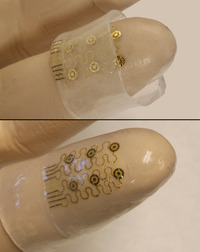I’ve read the news release and briefly skimmed the research paper and cannot find any discussion of how these scientists got the idea to ‘recycle’ used cigarette butts for energy storage (supercapacitors) although the inspiration seems to have its roots in a desire to create better supercapacitors from recycled materials. From an Aug. 5, 2014 news item on ScienceDaily,
A group of scientists from South Korea have converted used-cigarette butts into a high-performing material that could be integrated into computers, handheld devices, electrical vehicles and wind turbines to store energy.
Presenting their findings today, 5 August 2014, in IOP Publishing’s journal Nanotechnology, the researchers have demonstrated the material’s superior performance compared to commercially available carbon, graphene and carbon nanotubes.
It is hoped the material can be used to coat the electrodes of supercapacitors — electrochemical components that can store extremely large amounts of electrical energy — whilst also offering a solution to the growing environmental problem caused by used-cigarette filters.
An Aug. 5, 2014 Institute of Physics (IOP) news release (also on EurekAlert), which originated the news item, further describes the situation regarding used cigarette butts and the characteristics that could render them into supercapacitors
It is estimated that as many as 5.6 trillion cigarette butts (equivalent to 766 571 metric tons), are deposited into the environment worldwide every year.
Co-author of the study Professor Jongheop Yi, from Seoul National University, said: “Our study has shown that used cigarette filters can be transformed into a high-performing carbon-based material using a simple one-step process, which simultaneously offers a green solution to meeting the energy demands of society.
“Numerous countries are developing strict regulations to avoid the trillions of toxic and non-biodegradable used cigarette filters that are disposed of into the environment each year; our method is just one way of achieving this.”
Carbon is the most popular material that supercapacitors are composed of, due to its low cost, high surface area, high electrical conductivity and long-term stability.
Scientists around the world are currently working towards improving the characteristics of supercapacitors – such as energy density, power density and cycle stability – while also trying to reduce production costs.
In their study, the researchers demonstrated that the cellulose acetate fibres that cigarette filters are mostly composed of could be transformed into a carbon-based material using a simple, one-step burning technique called pyrolysis.
As a result of this burning process, the resulting carbon-based material contained a number of tiny pores, increasing its performance as a supercapacitive material.
“A high-performing supercapacitor material should have a large surface area, which can be achieved by incorporating a large number of small pores into the material,” continued Professor Yi.
“A combination of different pore sizes ensures that the material has high power densities, which is an essential property in a supercapacitor for the fast charging and discharging.”
Once fabricated, the carbon-based material was attached to an electrode and tested in a three-electrode system to see how well the material could adsorb electrolyte ions (charge) and then release them (discharge).
The material stored a higher amount of electrical energy than commercially available carbon and also had a higher amount of storage compared to graphene and carbon nanotubes, as reported in previous studies.
Here’s a link to and a citation for the research paper,
Preparation of energy storage material derived from a used cigarette filter for a supercapacitor electrode by Minzae Lee, Gil-Pyo Kim, Hyeon Don Song, Soomin Park, and Jongheop Yi. Nanotechnology 25 (34) 5601 doi:10.1088/0957-4484/25/34/345601
This is an open access paper.

